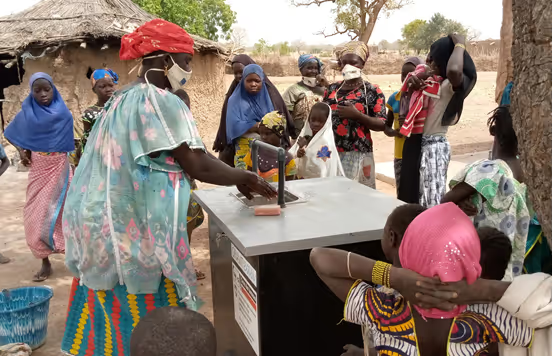Strengthening Child-Friendly Sanitation in Rohingya Refugee Camps

Project overview
ICDDR,B developed a child-friendly latrine and handwashing station design through a participatory process in which children and caregivers identified barriers and co-created practical, context-specific solutions.
Project solution
This project offers [specific solution or intervention] to tackle [challenge]. By implementing [strategies, tools, or innovations], the project aims to achieve [desired outcomes]. The approach is designed to [specific actions or methods] to bring about meaningful change in [community, region, or issue area].
Expected outcomes
This project aims to achieve [specific outcomes], such as [measurable results, improvements, or changes]. The expected impact includes [benefits to the target community, advancements in research or innovation, or long-term effects]. By the end of the project, we anticipate [specific changes or milestones] that will contribute to [broader goals or objectives].
WHAT HUMANITARIAN NEED WAS ADDRESSED?
Humanitarian WASH interventions often prioritise adult sanitation needs and develop structures that primarily support this vulnerable population. The absence of child-friendly features in WASH infrastructure, such as latrines and handwashing stations, forces children to resort to unhealthy sanitation practices that jeopardise their physical and mental well-being. Poor sanitation among children increases the risk of waterborne diseases within camps, undermining humanitarian organisations' efforts to ensure safe WASH access for all age groups.
HOW DID THE INNOVATIVE SOLUTION IMPACT HUMANITARIAN PRACTISE?
A User-Centered Community Engagement (UCCE) method was adopted to develop innovative, child-friendly latrines and handwashing stations. An initial Interactive Digital Survey (IDS 1) was conducted to identify barriers preventing children from accessing sanitation facilities. Based on these findings, problem trees were developed and presented in six co-creation sessions to identify context-appropriate, user-specific solutions. A voting process among children and caregivers was facilitated to prioritize children’s sanitation needs and proposed solutions. Based on suggestions from the community, ICDDR,B developed child-friendly latrine and handwashing station prototypes designed to enable children to use WASH facilities safely, comfortably, and independently.
WHAT PROGRESS WAS ACHIEVED AND WHAT WERE THE KEY LEARNINGS?
A total of 80 child-friendly latrines and handwashing stations were installed in the selected camps based on the developed prototype. Following construction, Interactive Digital Survey (IDS 2) was conducted, which revealed significant increases in latrine use and perceived satisfaction levels among children and caregivers. Respondents also reported fewer obstacles to access and an increased sense of safety and security at night. The handwashing station design was widely appreciated by both the community and stakeholders due to its permanent structure, improved water disposal system, and reduced risk of structural theft.
A key takeaway from the project was that the acceptance of innovations depends heavily on effective communication with community members. Providing clear information to the community and children about the purpose of modifying WASH infrastructure played a vital role in increasing facility use and satisfaction levels.
FUTURE POTENTIAL AND LESSONS FOR INNOVATION
This innovation holds promise for ensuring safe sanitation for children in emergency settings, thereby enhancing hygiene practices and ultimately reducing the incidence of waterborne diseases. By utilising locally available construction materials and incorporating design changes easily understood by local masons, the approach can be replicated in other camp settings to benefit children. Given these benefits, many WASH stakeholders working in other Forcibly Displaced Myanmar Nationals (FDMN) camps have expressed interest in adopting the innovation to improve children's safety and well-being.
The User-Centered Community Engagement (UCCE) method applied in this project was developed to train field-level managers on rapid problem-solving in crisis-affected settings. Adoption of this method can play a vital role in designing solutions for a range of WASH challenges, making it a valuable tool for future humanitarian innovations.
DISSEMINATION
01/07/2025-31/12/2025
Building on the innovation developed and tested during the initial implementation phase, engagement with local WASH stakeholders and government actors was carried out to showcase the results. With the support of a dissemination grant, efforts are underway to reach broader global and national audiences to raise awareness of the innovation and enhance opportunities for scaling up in diverse settings, such as informal settlements, to benefit marginalised populations. Future plans also include creating and fostering collaborations with WASH stakeholders who share similar interests in scaling up the UCCE method to address evidence-based, child-centric sanitation needs.
Project delivery & updates
Stay up to date with the latest developments from this project. Here, you will find details on what has been delivered, resources created, and regular updates as the project progresses. Access key documents, reports, and other materials to see how the project is making an impact.